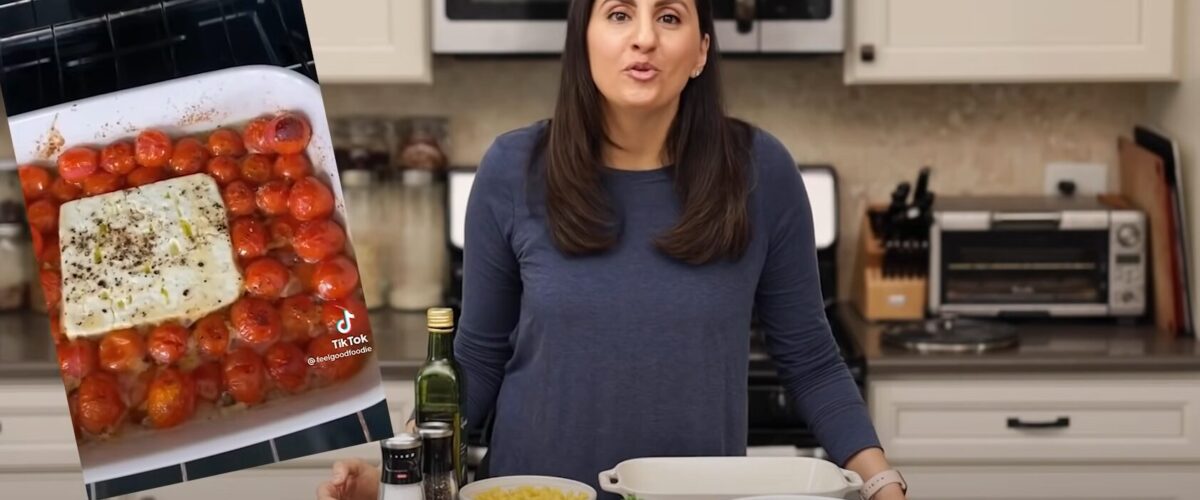Feta Pasta was 2021’s recipe of the moment – cooked millions of times on TikTok, visually appealing, easy to make, and surprisingly satisfying. But how did this massive hype emerge? And why did the dish disappear almost as quickly as it went viral? This article analyzes the Feta Pasta phenomenon as a textbook example of modern recipe virality: a perfect storm of algorithm-driven exposure, pandemic-era routines, and psychological reward systems. We trace the rise and fall of a digital pasta classic – and what it reveals about the mechanics of food trends.
Trend Snapshot / Factbox
| Aspect | Details |
|---|---|
| Trend name and brief definition | Baked Feta Pasta – a simple pasta dish with oven-baked feta and tomatoes |
| Main ingredients or key components | Feta cheese, cherry tomatoes, garlic, olive oil, pasta, basil |
| Current distribution (where can you find this trend now?) | Mostly on TikTok & Instagram, rarely in restaurants anymore |
| Well-known restaurants or products currently embodying this trend | Few; mostly a homecooking trend |
| Relevant hashtags and social media presence | #fetapasta, #bakedfetapasta, #tiktokpasta |
| Target demographics (who mainly consumes this trend?) | Home cooks, especially Gen Z and Millennials |
| “Wow factor” or special feature of the trend | Melted cheese & instant success when replicating it |
| Trend phase (emerging, peak, declining) | Declining; peaked in early 2021 |
A Finnish Recipe, a Global Hit
The origin of Feta Pasta lies not in the US, but in Finland. Food blogger Jenni Häyrinen published her version of “Uunifetapasta” – oven-baked feta pasta – back in 2019. The recipe already caused a small sensation in Finland, with feta cheese selling out in supermarkets due to surging demand. But the global breakthrough came through TikTok. When US food blogger MacKenzie Smith posted a 30-second video of the dish in January 2021, a viral wave began. Millions of views, thousands of user remixes, and a dish that seemed to enter every home kitchen overnight.
The Perfect Recipe for the TikTok Algorithm
Feta Pasta was almost custom-built for TikTok’s algorithmic ecosystem. The platform rewards videos that are watched through to the end – and what better candidate than a short, visually satisfying cooking clip? The melted cheese, the steaming tomatoes, the moment of stirring – all trigger visual and emotional pleasure. At the same time, the recipe was so easy that virtually anyone could replicate it. Few ingredients, no special skills, minimal equipment. It was the ideal combination of snackable content and real-life value. TikTok didn’t just host the trend – it needed it.
Viral by Design: A Recipe Made for Participation
What separated Feta Pasta from a standard viral clip was its participatory challenge appeal. The recipe wasn’t just for watching – it begged to be recreated. Users could post their own versions: with extra garlic, vegan feta, different pasta types, or fancy toppings. This adaptability sparked a self-reinforcing loop, where each remix became part of the trend. The platform rewarded this behavior with visibility, and creators earned likes and engagement. Similar trends like Cloud Bread or Baked Oats followed the same pattern: simple idea, strong visuals, low barriers to entry. The social hook was clear – if you wanted to be part of the moment, you had to post your feta.
Minimal Effort, Maximum Hack Appeal
The psychological pull of Feta Pasta was rooted in the zeitgeist of the pandemic. In a time when people were stuck between home office, lockdowns, and anxiety, the recipe offered a low-effort path to a tangible reward. It felt like a lifehack: minimal input, maximum output. The result was comforting, visually aesthetic, and deeply shareable. For Gen Z and younger Millennials especially, it hit the sweet spot – productive without pressure, creative without chaos, communal without contact. Participating in the trend meant more than eating – it meant being part of a global cooking moment.
Why It Vanished So Quickly
Just as quickly as Feta Pasta exploded, it faded from view. The very traits that made it viral also made it burn out fast. It had limited flexibility, a flavor profile that not everyone loved, and a visual novelty that wore off with repetition. TikTok’s content cycle doesn’t favor longevity – once something becomes “old news,” it’s deprioritized in the feed. New contenders like Pasta Chips, Nature’s Cereal or Butter Boards soon replaced the cheese-and-tomato classic. Feta Pasta was a one-hit wonder of viral food culture.
Mocked Today, Loved Back Then: A Feta Retrospective
Today, Feta Pasta rarely appears on the For You Page. YouTube retrospectives and nostalgic TikTok clips treat it more as a relic of the pandemic era than a current recipe. Creators now reflect on it with ironic distance: “Still tastes mid tbh,” or “It was a vibe, not a meal.” But that ironic tone also underscores just how emblematic the dish was of its moment. It represents a collective online experience, shaped by platform mechanics, psychological needs, and social dynamics. For food professionals, it remains a case study in how recipes circulate – and why flavor alone no longer guarantees attention.
Feta Pasta was more than a recipe – it was a moment. Born from algorithms, collective needs, and kitchen creativity, it shows how digital food trends form, accelerate, and dissolve. Anyone looking to understand what we’ll cook tomorrow should take a close look at its story.

